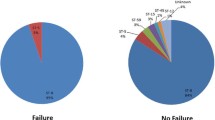Abstract
Staphylococcus aureus is the most common cause of skin and soft tissue infections (SSTIs). Such infections have increased in several countries recently and at a time when community-associated methicillin-resistant S. aureus (CA-MRSA) strains have emerged globally. We examined changes in Australian hospitalisations for the treatment of cutaneous abscesses between 1999 and 2008, a period when increased numbers of CA-MRSA infections were being reported. National hospitalisation data for cutaneous abscess treatment (1999–2008) were examined. Hospitalisation numbers were collated and age-specific admission rates calculated and examined for changes over time. Yearly admissions for the treatment of cutaneous abscesses increased by 48%, from 8,849 (1999–2000) to 13,126 (2007–2008). The crude annual hospitalisation rate per 100,000 population rose from 46 to 62 respectively. However, increases in admission rates were limited to the 10 to 54 years age range. Incidence rate ratios (IRRs) for final versus baseline year admission rates for these age groups ranged from 1.36 (95% confidence interval [CI] 1.04–1.78) for those aged 10–14 years to 1.64 (95% CI 1.26–2.12) for those aged 45–49 years; p < 0.05. Increases in hospitalisation for cutaneous abscess treatment have occurred in Australia during the last decade. Research into the underlying causes and prevention of these infections is a public health priority.

Similar content being viewed by others
References
Gould IM (2009) Antibiotics, skin and soft tissue infection and meticillin-resistant Staphylococcus aureus: cause and effect. Int J Antimicrob Agents 34(Suppl 1):S8–S11. doi:10.1016/S0924-8579(09)70542-4
Dryden MS (2009) Skin and soft tissue infection: microbiology and epidemiology. Int J Antimicrob Agents 34(Suppl 1):S2–S7. doi:10.1016/S0924-8579(09)70541-2
Hersh AL, Chambers HF, Maselli JH, Gonzales R (2008) National trends in ambulatory visits and antibiotic prescribing for skin and soft-tissue infections. Arch Intern Med 168(14):1585–1591. doi:10.1001/archinte.168.14.1585
Moran GJ, Krishnadasan A, Gorwitz RJ, Fosheim GE, McDougal LK, Carey RB, Talan DA (2006) Methicillin-resistant S. aureus infections among patients in the emergency department. N Engl J Med 355(7):666–674. doi:10.1056/NEJMoa055356
Vandenesch F, Naimi T, Enright MC, Lina G, Nimmo GR, Heffernan H, Liassine N, Bes M, Greenland T, Reverdy ME, Etienne J (2003) Community-acquired methicillin-resistant Staphylococcus aureus carrying Panton–Valentine leukocidin genes: worldwide emergence. Emerg Infect Dis 9(8):978–984
Coombs GW, Nimmo GR, Pearson JC, Christiansen KJ, Bell JM, Collignon PJ, McLaws ML (2009) Prevalence of MRSA strains among Staphylococcus aureus isolated from outpatients, 2006. Commun Dis Intell 33(1):10–20
Nimmo GR, Coombs GW (2008) Community-associated methicillin-resistant Staphylococcus aureus (MRSA) in Australia. Int J Antimicrob Agents 31(5):401–410. doi:10.1016/j.ijantimicag.2007.08.011
Australian Institute of Health and Welfare (AIHW) (2010) Separation, patient day and average length of stay statistics by principal diagnosis in ICD-10-AM, Australia,1998–99 to 2007–08. L02 Cutaneous abscess, furuncle and carbuncle. AIHW. Available online at: http://www.aihw.gov.au/data-cube/?id=6442475319. Accessed 26 November 2010
Australian Bureau of Statistics (2010) 3201.0 - Population by Age and Sex, Australian States and Territories, Jun 2009. TABLE 9. Estimated Resident Population By Single Year of Age, Australian Capital Territory. Australian Bureau of Statistics. Available online at: http://www.abs.gov.au/AUSSTATS/abs@.nsf/DetailsPage/3201.0Jun%202009?OpenDocument. Accessed 26 November 2010
Glynn RJ, Buring JE (1996) Ways of measuring rates of recurrent events. BMJ 312(7027):364–367
Australian Government, Department of Health and Ageing (2010) Round 13 (2008–09) Cost Report - Public interim version 6.0, Public version 5.2, Private version 5.1 and Private Day Hospital Facilities (Standalone) version 5.1. Australian Government, Department of Health and Ageing. Available online at: http://www.health.gov.au/internet/main/publishing.nsf/Content/Round_13-cost-reports. Accessed 26 November 2010
O’Sullivan CE, Baker MG (2010) Proposed epidemiological case definition for serious skin infection in children. J Paediatr Child Health 46(4):176–183. doi:10.1111/j.1440-1754.2009.01658.x
Nimmo GR, Fong J, Paterson DL, McLaws ML (2008) Changing epidemiology of meticillin-resistant S. aureus in Queensland, Australia, 2000–2006: use of passive surveillance of susceptibility phenotypes. J Hosp Infect 70(4):305–313. doi:10.1016/j.jhin.2008.07.003
Pandey R (2008) Emergence of non-multiresistant methicillin-resistant Staphylococcus aureus as the commonest pathogen causing skin infections in a rural Australian city. J Infect 56(5):393–394. doi:10.1016/j.jinf.2008.01.048
Australian Institute of Health and Welfare (AIHW) (2010) Separation, patient day and average length of stay statistics by principal diagnosis in ICD-10-AM, Australia,1998–99 to 2007–08. AIHW. Available online at: http://www.aihw.gov.au/data-cube/?id=6442475319. Accessed 26 November 2010
Munckhof WJ, Nimmo GR, Carney J, Schooneveldt JM, Huygens F, Inman-Bamber J, Tong E, Morton A, Giffard P (2008) Methicillin-susceptible, non-multiresistant methicillin-resistant and multiresistant methicillin-resistant Staphylococcus aureus infections: a clinical, epidemiological and microbiological comparative study. Eur J Clin Microbiol Infect Dis 27(5):355–364. doi:10.1007/s10096-007-0449-3
Nimmo GR, Schooneveldt JM, Sutherland JL, Power S, Olesen D, Selvey C, Beard F, Jones M, Paterson DL (2010) Epidemiology of non-multiresistant methicillin-resistant Staphylococcus aureus infection in Queensland, Australia: associations with indigenous populations and Panton–Valentine leukocidin. Eur J Clin Microbiol Infect Dis 29(10):1253–1259. doi:10.1007/s10096-010-0994-z
Muttaiyah S, Coombs G, Pandey S, Reed P, Ritchie S, Lennon D, Roberts S (2010) Incidence, risk factors, and outcomes of Panton–Valentine leukocidin-positive methicillin-susceptible Staphylococcus aureus infections in Auckland, New Zealand. J Clin Microbiol 48(10):3470–3474. doi:10.1128/JCM.00911-10
Maree CL, Eells SJ, Tan J, Bancroft EA, Malek M, Harawa NT, Lewis MJ, Santana E, Miller LG (2010) Risk factors for infection and colonization with community-associated methicillin-resistant Staphylococcus aureus in the Los Angeles County jail: a case–control study. Clin Infect Dis 51(11):1248–1257. doi:10.1086/657067
Hayward A, Knott F, Petersen I, Livermore DM, Duckworth G, Islam A, Johnson AM (2008) Increasing hospitalizations and general practice prescriptions for community-onset staphylococcal disease, England. Emerg Infect Dis 14(5):720–726
Edelsberg J, Taneja C, Zervos M, Haque N, Moore C, Reyes K, Spalding J, Jiang J, Oster G (2009) Trends in US hospital admissions for skin and soft tissue infections. Emerg Infect Dis 15(9):1516–1518
Klein E, Smith DL, Laxminarayan R (2007) Hospitalizations and deaths caused by methicillin-resistant Staphylococcus aureus, United States, 1999–2005. Emerg Infect Dis 13(12):1840–1846
Saxena S, Thompson P, Birger R, Bottle A, Spyridis N, Wong I, Johnson AP, Gilbert R, Sharland M (2010) Increasing skin infections and Staphylococcus aureus complications in children, England, 1997–2006. Emerg Infect Dis 16(3):530–533
Author information
Authors and Affiliations
Corresponding author
Rights and permissions
About this article
Cite this article
Vaska, V.L., Nimmo, G.R., Jones, M. et al. Increases in Australian cutaneous abscess hospitalisations: 1999–2008. Eur J Clin Microbiol Infect Dis 31, 93–96 (2012). https://doi.org/10.1007/s10096-011-1281-3
Received:
Accepted:
Published:
Issue Date:
DOI: https://doi.org/10.1007/s10096-011-1281-3



